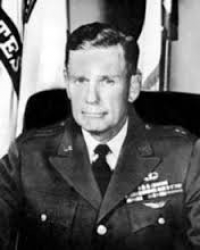
 |
|
|
||
|
Hamilton Hawkins Howze |
||||
|
Graduate, U.S. Military Academy, Class of 1930 Engagements: • World War II (1941 - 1945) |
||||
| Biography: | ||||
|
Hamilton Hawkins Howze Hamilton Hawkins Howze was born on 21 December 1908 at West Point, NY, while his father, Major General Robert Lee Howze, an 1888 USMA graduate and Medal of Honor recipient, was serving as Commandant of the U.S. Military Academy. Howze attended West Point, graduating in the Class of 1930. He was commissioned a Second Lieutenant in the Cavalry and assigned to the 6th Cavalry Regiment. In WWII he served as the Commander of: 2nd Battalion, 13th Armor Regiment (1943); 13th Armor Regiment (1943-44); and 1st Armored Division, Italy (1944-45). After the war, Howze served as the G-3 of the 1st Armored Division in 1946. Three years later, he attended the National War College, which was followed by an assignment in the office of the G-2 from 1949 to 1952. After promotion to Brigadier General in 1952, he became Assistant Commanding General, 2nd Armored Division, European Command, until 1954. Air Mobility Howze is recognized as the intellectual force behind the concept of air-mobility and current U.S. Army Aviation doctrine. While serving as the first Director of Army Aviation, Department of the Army, from 1955-58, he developed new tactical principles for the employment of Army Aviation, and was instrumental in helping the Aviation Center and School become fully established in its new home at Fort Rucker, AL. He then became Commanding General of the 82d Airborne Division. In 1961, as Chairman of the Tactical Mobility Requirements Board, Howze led the development in airmobile theory and doctrine. The Army's adoption of the recommendations in the Howze Board changed mobile warfare. Its revolutionary concepts - based on the use of aviation - changed military attitudes in a similar manner to the way the tank affected ideas on mobility 50 years earlier. Two years later, the 11th Air Assault Division was formed to test and validate these concepts. As a result of Howze's leadership, foresight, and perception, two air-mobile divisions were eventually established. These divisions, which still adhere to the fundamentals of Howze's air-mobility doctrine, have gone on to provide mobile and combined arms capabilities that are required in today's ground combat conditions. Final Commands Lieutenant General Howze served as Commander of the XVIII Airborne Corps and briefly, as acting-Commanding General, Third U.S. Army. His last assignment was as Commanding General, Eighth U.S. Army, Commander-in-Chief, U.S. Forces Korea, a four-star United Nations Command involving U.S. and Republic of Korea troops, from 1963 to 1965. General Howze retired from active duty in 1965 and relocated to Fort Worth, Texas. (Hamilton's brother, Robert Lee Howze, retired as a Major General in the U.S. Army.) Medals, Awards and Badges Army Distinguished Service Medal Foreign Medals Italian Military Valor Cross Silver Star Medal Citation The President of the United States of America, authorized by Act of Congress July 9, 1918, takes pleasure in presenting the Silver Star to Lieutenant Colonel (Cavalry) Hamilton Hawkins Howze (ASN: 0-18088), United States Army, for gallantry in action on *****, 1943, in the vicinity of *****, Tunisia. Lieutenant Colonel Howze efficiently and aggressively directed the operation of the Second Battalion, 13th Armored Regiment, 1st Armored Division, in an attack which penetrated a strongly defended enemy position. Despite very heavy enemy artillery, anti-tank, and small arms fire he completely disregarded his own welfare by moving about on foot among his tanks in order to expedite their movement in the most favorable direction during the decisive phase of the battle. His aggressive leadership and courage served as an inspiration to his men and contributed materially to the successful accomplishment of his mission. His actions reflect great credit upon himself and the command and are highly commendable. General Orders: Headquarters, 1st Armored Division, General Orders No. 48 (May 19, 1943) In Retirement Howze remained active after leaving the Army and became a senior executive with an aviation company. As a 1957 Charter Member of the Army Aviation Association, he served for four years as the organization's Senior Vice President and President. He was also a member of the Army Aviation Hall of Fame and was the Chairman of the AAAA's Hall of Fame Board of Trustees. Death and Burial General Hamilton Hawkins Howze died on 8 December 1998. He is buried at the United States Military Academy Post Cemetery in West Point, Orange County, NY, in Section I, Row A, Grave 002. His grave is located next to his father's grave. Howze's wife, Mary Henry Howze was buried next to her husband after her death on 26 February 2009. |
||||
| Honoree ID: 257 | Created by: MHOH | |||
Ribbons
Medals
Badges
Honoree Photos
 |  |  |
 |  |
 |


